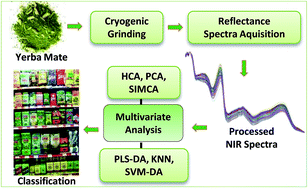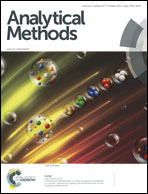Methods of multivariate analysis of NIR reflectance spectra for classification of yerba mate
Abstract
The present article is about a method of classification for yerba mate (Ilex paraguariensis), native to South America. Yerba mate samples were ground in a cryogenic mill and the near-infrared (NIR) reflectance of milled samples was directly measured. Hierarchical cluster analysis (HCA), principal components analysis (PCA), k-nearest neighbour (kNN), soft independent modelling class analogy (SIMCA), partial least square discriminant analysis (PLS-DA), and support vector machine discriminant analysis (SVM-DA) were used for multivariate analysis of the NIR reflectance spectra. Fifty-four brands of yerba mate from Argentina, Brazil, Paraguay and Uruguay were analyzed to classify the commercialized product by country of origin. For all intervals of the NIR reflectance spectrum evaluated (4435–4318 cm−1, 4358–4200 cm−1, 4436–4200 cm−1, and 4673–4200 cm−1), the SVM-DA classification of all brands was 100% correct. The kNN classification was not 100% correct in any interval. Classification via PCA, HCA and SIMCA was 100% correct for the 4435–4318 cm−1 interval. PLS-DA classification was 100% correct for the 4358–4200 cm−1 and 4435–4318 cm−1 intervals.

- This article is part of the themed collection: Analytical Sciences in Brazil

 Please wait while we load your content...
Please wait while we load your content...